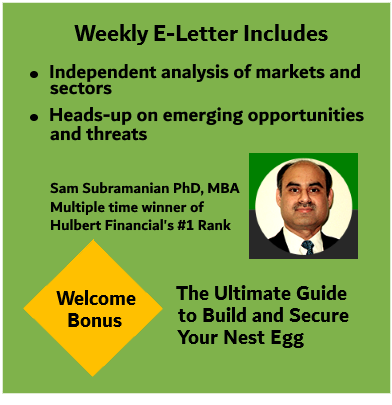The favorable dynamics for the Biotechnology industry is attracting investor attention. On the heels of recent gains, there are reasons to be optimistic on continued out-performance.
An efficient Food and Drug Administration, progress on extension of new products, trouble in ‘major pharma’ land and reasonable valuation create a favorable milieu for investing in the biotechnology sector. These conditions have not gone unnoticed by investors on Wall Street. Since the beginning of 2004, the Fidelity Select® Biotechnology Fund (FBIOX), that concentrates its investments in this sector, is up 9.9% compared to 2.6% for the broader Wilshire 5000® Total Market Index. Investors have also warmed up to biotech IPOs helping companies like Dynavax Technologies (NDQ: DVAX), Renovis (NDQ: RNVS), and Corgentech (NDQ: CGTK) get out of the gate.
The Food and Drug administration has gotten its act together.
Approval times for new drugs have been significantly reduced. Last year Millennium Pharmaceuticals (NDQ: MLNM) got FDA approval for its treatment of multiple myeloma, a form of blood cancer, in four months after filing the application. This year, approval for Genentech’s (NDQ: DNA) cancer formulary, Avastin, came earlier than expected. Well-managed companies like DNA have also shortened the lead time to market from their end. The company launched the drug literally within hours of getting approval for Avastin. Elan (NYSE: ELN ) and Biogen Idec (NDQ: BIIB) are working to expedite the approval for their multiple sclerosis drug, Antegren, about a year earlier than expected.
Growth from new products.
he quest for new applications of existing therapies is vigorous. DNA is targeting to become a power house in oncology. Building on the success of Avastin against colorectal cancer, the company is targeting the drug’s application towards other forms of cancer including kidney, pancreas,and lung.
| “The quest for new applications of existing therapies is vigorous. Increasing the weighting of an investment portfolio towards this aggressive industry group of the healthcare sector may prove timely for venturesome investors.” |
Avastin works by inhibiting blood vessel formation. The company is also working on 5 new cancer drugs. Such efforts should help DNA achieve its goal of growing EPS at over a 20% clip for several years beyond 2005. Likewise, MLNM is seeking to derive higher revenues from its cancer product, Velcade. Seeking to extend the application of Velcade beyond multiple myeloma to several other types of cancer, the company will have about 80 different trials by the end of 2004. MLNM is also working with European regulators for the approval of Velcade across the pond.
Given its dominant position in the industry, no analysis of the biotechnology industry group is complete without looking at Amgen (NDQ: AMGN). The Thousand Oaks, CA based sector flagship recently received FDA approval for Sensipar that is used to treat hyperparathyroidism stemming from chronic kidney disease. AMGN is working on increasing the target patient population for Sensipar from 300,000 to 1 million by showing the drug’s utility as a pre-dialysis therapy. With no significant competing drugs in this space, revenues from this drug could add up to be significant for AMGN. The company is also working to expand the usage for Enbrel that is currently used to treat various inflammatory diseases.
While the impact of the successes of research on future sales of biotechnology drug companies is obvious, such efforts also place more demands on biological agents and research tools. The latter along with the need to combat the threat of bioterrorism provides opportunities for companies like Invitrogen (NDQ: IVGN). IVGN acquired BioReliance earlier this year to improve its ribonucleic acid interference research. This acquisition will likely add about $130 million to IVGN’s annual revenues to push IVGN’s annual revenues beyond the $1 billion mark.
The travails of ‘major pharma’.
Upcoming patent expirations, that make room for low-cost generic substitutes, embattle the drug pipelines of major pharmaceutical companies like of GlaxoSmithKline (NYSE: GSK). One area major pharma companies are increasingly looking to shape up their fitness, is biotechnology. Development stage biotechnology companies with strong domain expertise are likely beneficiaries as major pharma companies seek collaborative drug development efforts and provide the financial and marketing muscle. GSK for example has collaborative programs with Exelixis (NDQ: EXEL) and Vertex Pharmaceuticals (NDQ: VRTX). GSK also has three compounds derived from Human Genome Sciences’ (NDQ: HGSI) database that are in clinical trials.
Valuation.
With the growth and excitement of new products and applications, the biotechnology industry group has seldom been fertile ground for the traditional value investor. Here is a quick look at the financial metrics of AMGN and DNA.
|
|||||||||||||||
| Source: Yahoo! Finance. |
The prospects for sales and earnings growth for both AMGN and DNA are in excess of 20% with DNA’s prospects perhaps being higher. AMGN’s operating margins are a robust 50% in comparison to DNA’s 32%. Wall Street has been enamored with DNA’s news flow and bid up the company’s shares higher. By the same token, investors have been concerned with Medicare reimbursement rates for AMGN’s anemia treatment, Epogen. Wall Street has viewed AMGN more as a pharmaceutical company and has not given much credit for its deep drug development pipeline that includes potential $1 billion opportunities in formulations for osteoporosis (AMG162) and mouth sores (Paliferrin). Recently, AMGN also acquired the 80% of Tularik (NDQ: TLRK) it does not own. This acquisition gives AMGN development programs in cancer, auto-immune diseases and metabolic diseases. To us, AMGN appears attractively priced from a historical perspective on most metrics.
Although biotechnology companies in the aggregate need more years to get to profitability, the winds for investing in the biotechnology sector appear favorable. The optimism however needs to be balanced with the virtual certainty that some of the research and development efforts in this industry will fail to deliver on promises. All said, increasing the weighting of an investment portfolio towards this aggressive industry group of the healthcare sector may prove timely for venturesome investors.

 Sick buying high & selling low? Fed up of the fees you pay? Tired researching investments? End your financial pain now. You have the opportunity to
Sick buying high & selling low? Fed up of the fees you pay? Tired researching investments? End your financial pain now. You have the opportunity to 

 DEC. 1993 to DEC. 2023
DEC. 1993 to DEC. 2023





